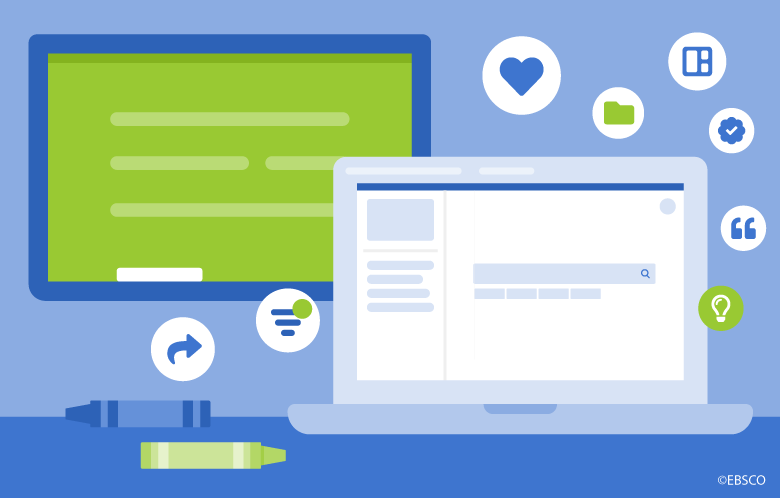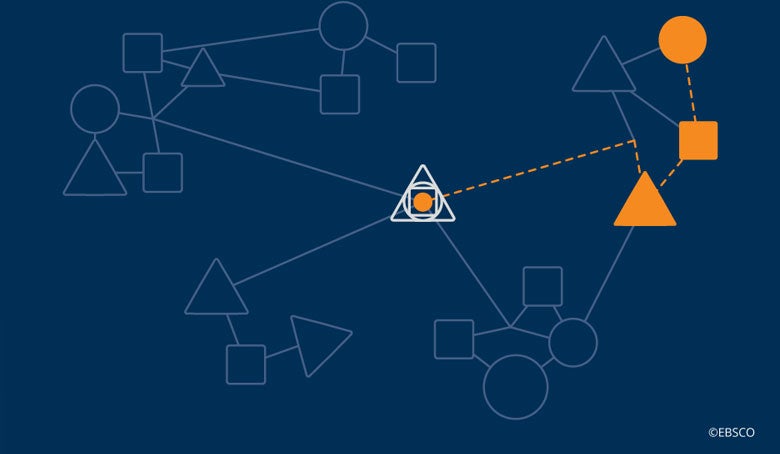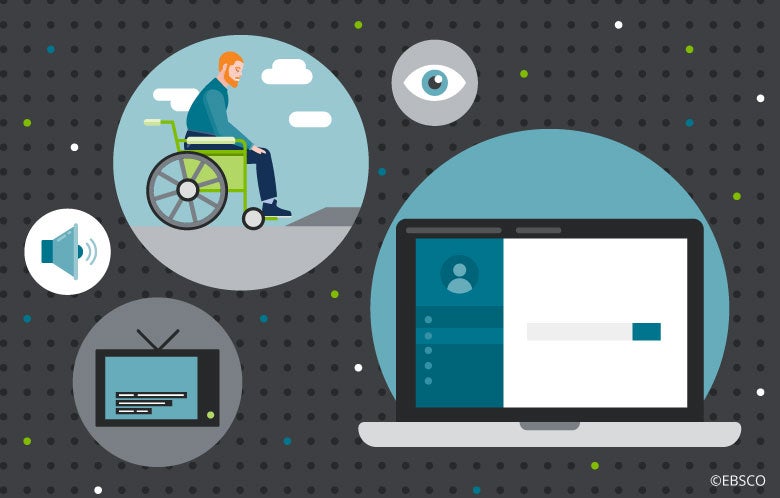EBSCO Discovery Service™ (EDS) has long been known as the library search superpower, with unparalleled prowess at finding a library’s holdings, be they on the shelf or online, whether they are books, magazines, journals, videos, recordings and beyond.
EDS is now augmenting its powers by upgrading its search experience, delivering a new, redesigned user interface (UI) that improves how students can access, search, choose, and use library assets. The reimagined UI includes features found on websites like Amazon™, Spotify™, Netflix™ or Google™, and blends them with the elements common to a library search site. The end-product represents an evolution in EDS, with the addition of sharing options, recommendation capabilities and personalized dashboards.
This new incarnation of EDS gives students the ability to access the library’s online holdings on any device, no matter where the students are, or when they are doing their research. With Ping, Okta, or other SAML-compliant identity solutions like Microsoft ADFS, EDS provides privacy-protected single-sign on, allowing the students to maintain a secret identity. If students find links to assets on other platforms, personalized authentication connections are provided via OpenAthens, which also supplies precise control and usage data to library managers.
If a student is using Google Scholar™, they can connect to EBSCOhost® and with the help of Google CASA™ and Universal CASA, retrieve full text results. The new EDS is also LTI (Learning Tools Interoperability) 1.3 compliant, so if students are using learning management systems such as Canvas™, Moodle™, or Blackboard™, accessing assigned content is instantaneous as they have already been authenticated by their LMS.
While easy access is a key feature of the new EDS experience, accessibility is also of critical importance. EBSCO has a partnership with The Carroll Center for the Blind, in Newton, Massachusetts, that focuses on testing for accessibility from the earliest stages of software development. This accessibility-first philosophy has led to an interface that is not just better for those with special needs, but rather better for ALL students. In keeping with this mindset, EBSCO is advancing toward WCAG 2.1 AA compliance and has been named a top e-book platform provider by the ASPIREverified Accessibility Audit, with a score of 100 percent.
EDS also does more than just help students find resources. EDS helps guide students toward improving their search terms and locating results they may have missed under other circumstances. As a result, students who are novice researchers develop their information literacy skills and, as they gain greater expertise in searching for materials, can also grow to have a greater appreciation for the library.
The new EDS serves as more than just a discovery service. It is also a learning environment. The “smarts” behind EDS is the Knowledge Graph. The Knowledge Graph is derived from the work of a multitude of subject matter experts drawing on numerous subject indexes. The reason why students can find expert information from EDS — even if they aren’t world-class researchers — is because of the work the Knowledge Graph is doing behind the scenes.
The Knowledge Graph does this by mapping new datasets that incorporate natural language, extensive subject vocabularies and a massive collection of synonyms and concepts in more than 280 languages and dialects. This helps in several ways as it lets students enter search terms in their native languages and boosts relevance and search rankings for EDS and EBSCOhost.
The Knowledge Graph can also help find connections between subjects by using the EDS Concept Map. The Concept Map is a visual representation of related subjects and concepts laid out in a hub-and-spoke pattern that helps students discover relationships that may not be readily visible in a linear result list.
EDS is now augmenting its powers by upgrading its search experience, delivering a new, redesigned user interface (UI) that improves how students can access, search, choose, and use library assets.
EDS is now augmenting its powers by upgrading its search experience, delivering a new, redesigned user interface (UI) that improves how students can access, search, choose, and use library assets.
When a student types in a search in the Concept Map, the Knowledge Graph provides them multiple possible options in a drop-down menu so as to specify what they are looking for. Thus, if the student is looking for “band,” EDS lists multiple meanings of the word, and lets students choose which one they meant, whether it is a group of musicians, a range of frequencies, and so on. Essentially, there is no “right” or “expert” word for a query. This is equitable search — in that the student uses their own words and is still rewarded with expert results.
A search for “France,” for example, shows a picture of France at the hub, with a series of spokes branching out from it from it, each linking to a related concept, such as “Paris,” “Riviera,” or “Alps.” If a student wants to learn more about any of these, they can start a new search with a new query. This Concept Map style of presenting linked subjects fosters information literacy, as it helps students improve their talents at searching.
The new EDS user experience also features a modern result list with detailed filters that help students find the most on-target materials for their research. There is a “like” function for tagging items and saving them for later. Students can cite, add to a project, share references, and download items directly from the result list, all without having to open the items.
Students can also select which citation format they want, copy the citations, export them to tools such as Zotero™ or NoodleTools™, or email them. In addition, they can share to Google Classroom™, Google Drive™, or create a link for sharing on other platforms.
Plus, students can click to open articles in PDF or HTML formats. And, just as in the result list, students can use the new PDF viewer to cite, share and add to a project. From within the viewer, students can find the number of copies that are available to the library, and whether or not the title is currently being used.
There’s also a new e-book viewer in the upgraded EDS. It provides a fully accessible e-book viewing experience for EPUB (HTML) and PDF e-books, and enables students to cite, share and download entire EBSCO eBooks™ right from the result list. If students only need a few chapters, they can use the table of contents from within the viewer to navigate to and download sections of the book.
For libraries with Full Text Finder™, a new Publication Finder™ user interface offers browsing by alphabet, database, and hierarchical subject as well as a search box to quickly locate publications.
EBSCO is moving customers over to the new EDS based on their readiness. Current customers receive concurrent access to the old and new versions in order to acquaint themselves with the new features and provide feedback. Since the new EDS will be populated from existing profile configurations, the transition is a smooth one. Current clients can complete their move to the new interface when they feel ready, while new customers will start with the new UI.
The new EDS carries on its predecessor’s legacy of harnessing EBSCO’s robust search technology to deliver useful, on-target results across billions of records to millions of students. By pairing this search technology with an innovative new interface, students can supercharge their research capabilities, allowing them to get the most out of all the library has to offer.
Learn more about EDS’s upgrades and how it helps students become super searchers



